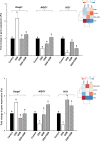Grape seed meal by-product is able to counteract oxidative stress induced by lipopolysaccharide and dextran sulphate in IPEC cells and piglets after weaning
- PMID: 37053301
- PMCID: PMC10101422
- DOI: 10.1371/journal.pone.0283607
Grape seed meal by-product is able to counteract oxidative stress induced by lipopolysaccharide and dextran sulphate in IPEC cells and piglets after weaning
Abstract
Oxidative stress is a pivotal factor in the pathogenesis of intestinal inflammation, leading to cellular damage and tissue injury. Natural antioxidants compounds found in agro-industrial by-products have proven their effectiveness in treatment of intestinal inflammation and oxidative stress, exhibiting many favourable effects. The aim of this study was to evaluate the capacity of a grape seed meal byproduct (GSM) to counteract the effects induced by E. coli lipopolysaccharide (LPS, 5μg/ml) in vitro on IPEC-1 cells and by dextran sulphate sodium (DSS, 1g/b.w./day) in vivo on piglets after weaning. Reactive oxygen species (ROS), pro-oxidant markers (malondialdehyde MDA, thiobarbituric acid reactive substances TBARS, protein carbonyl, DNA oxidative damage) antioxidant enzymes (catalase -CAT, superoxide dismutase -SOD, glutathione peroxidase -GPx, endothelial and inducible nitric oxide synthases -eNOS and iNOS) and several important components of Keap1/Nrf2 signalling pathway were analysed in IPEC-1 cells as well as in piglet's colon and lymph nodes. Our results demonstrated that GSM extract or 8% dietary GSM showed anti-oxidant properties counteracting the pro-oxidant response (ROS, MDA-TBARS, protein carbonyl, DNA/RNA damage) induced by LPS or DSS and restoring the levels of endogenous antioxidant enzymes, including CAT, SOD, GPx, eNOS and iNOS in colon and mesenteric lymph nodes. These beneficial effects were modulated via Nrf2 signalling pathway in both in vitro and in vivo studies.
Copyright: © 2023 Pistol et al. This is an open access article distributed under the terms of the Creative Commons Attribution License, which permits unrestricted use, distribution, and reproduction in any medium, provided the original author and source are credited.
Conflict of interest statement
The authors have declared that no competing interests exist.
Figures









Similar articles
-
Mo3Se4 nanoparticle with ROS scavenging and multi-enzyme activity for the treatment of DSS-induced colitis in mice.Redox Biol. 2022 Oct;56:102441. doi: 10.1016/j.redox.2022.102441. Epub 2022 Aug 14. Redox Biol. 2022. PMID: 35985164 Free PMC article.
-
Effects of zearalenone-induced oxidative stress and Keap1-Nrf2 signaling pathway-related gene expression in the ileum and mesenteric lymph nodes of post-weaning gilts.Toxicology. 2020 Jan 15;429:152337. doi: 10.1016/j.tox.2019.152337. Epub 2019 Nov 21. Toxicology. 2020. PMID: 31760079
-
S-allylmercaptocysteine ameliorates lipopolysaccharide-induced acute lung injury in mice by inhibiting inflammation and oxidative stress via nuclear factor kappa B and Keap1/Nrf2 pathways.Int Immunopharmacol. 2020 Apr;81:106273. doi: 10.1016/j.intimp.2020.106273. Epub 2020 Mar 5. Int Immunopharmacol. 2020. PMID: 32070920
-
Grape Pomace Polyphenols as a Source of Compounds for Management of Oxidative Stress and Inflammation-A Possible Alternative for Non-Steroidal Anti-Inflammatory Drugs?Molecules. 2022 Oct 12;27(20):6826. doi: 10.3390/molecules27206826. Molecules. 2022. PMID: 36296420 Free PMC article. Review.
-
[Selenium compounds in redox regulation of inflammation and apoptosis].Biomed Khim. 2019 Apr;65(3):165-179. doi: 10.18097/PBMC20196503165. Biomed Khim. 2019. PMID: 31258141 Review. Russian.
Cited by
-
Dietary Synbiotic Attenuated the Intestinal Inflammation in Weaned Piglets Challenged with Escherichia coli Lipopolysaccharide.Animals (Basel). 2025 Jun 20;15(13):1832. doi: 10.3390/ani15131832. Animals (Basel). 2025. PMID: 40646731 Free PMC article.
-
Natural Compounds That Activate the KEAP1/Nrf2 Signaling Pathway as Potential New Drugs in the Treatment of Idiopathic Parkinson's Disease.Antioxidants (Basel). 2024 Sep 18;13(9):1125. doi: 10.3390/antiox13091125. Antioxidants (Basel). 2024. PMID: 39334784 Free PMC article. Review.
-
Phytochemical Profiling and Bioactive Potential of Grape Seed Extract in Enhancing Salinity Tolerance of Vicia faba.Plants (Basel). 2024 Jun 8;13(12):1596. doi: 10.3390/plants13121596. Plants (Basel). 2024. PMID: 38931028 Free PMC article.
-
Effects of Grape By-Products on Oxidative Stress and Inflammation in Farm Animals: An Overview of Studies Performed in Pigs, Chickens, and Cattle.Animals (Basel). 2025 May 23;15(11):1536. doi: 10.3390/ani15111536. Animals (Basel). 2025. PMID: 40509002 Free PMC article. Review.
References
-
- Alemany-Cosme E., Saez-Gonzalez E, Moret I., Mateos B., Iborra M., Nos P., et al.. Oxidative Stress in the Pathogenesis of Crohn’s Disease and the Interconnection with Immunological Response, Microbiota, External Environmental Factors, and Epigenetics. Antioxidants (Basel). 2021;10(64):21. doi: 10.3390/antiox10010064 - DOI - PMC - PubMed
-
- Wang Y, Chen Y, Zhang X, Lu Y, Chen H. New insights in intestinal oxidative stress damage and the health intervention effects of nutrients: A review. Journal of Functional Foods. 2020;75:17. doi: 10.1016/j.jff.2020.104248 - DOI
Publication types
MeSH terms
Substances
LinkOut - more resources
Full Text Sources
Miscellaneous

